- Home
- About
- Map
- Trips
- Bringing Boat West
- Migration West
- Solo Motorcycle Ride
- Final Family XC Trip
- Colorado Rockies
- Graduates' XC Trip
- Yosemite & Nevada
- Colorado & Utah
- Best of Utah
- Southern Loop
- Pacific Northwest
- Northern Loop
- Los Angeles to NYC
- East Coast Trips
- Martha's Vineyard
- 1 Week in Quebec
- Southeast Coast
- NH Backpacking
- Martha's Vineyard
- Canadian Maritimes
- Ocracoke Island
- Edisto Island
- First Landing '02
- Hunting Island '02
- Stowe in Winter
- Hunting Island '01
- Lake Placid
- Chesapeake
- Provincetown
- Hunting Island '00
- Acadia in Winter
- Boston Suburbs
- Niagara Falls
- First Landing '99
- Cape Hatteras
- West Coast Trips
- Burning Man
- Utah Off-Roading
- Maui
- Mojave 4WD Course
- Colorado River Rafting
- Bishop & Death Valley
- Kauai
- Yosemite Fall
- Utah Off-Road
- Lost Coast
- Yosemite Valley
- Arizona and New Mexico
- Pescadero & Capitola
- Bishop & Death Valley
- San Diego, Anza Borrego, Joshua Tree
- Carmel
- Death Valley in Fall
- Yosemite in the Fall
- Pacific Northwest
- Utah Off-Roading
- Southern CA Deserts
- Yosemite & Covid
- Lake Powell Covid
- Eastern Sierra & Covid
- Bishop & Death Valley
- Central & SE Oregon
- Mojave Road
- Eastern Sierra
- Trinity Alps
- Tuolumne Meadows
- Lake Powell Boating
- Eastern Sierra
- Yosemite Winter
- Hawaii
- 4WD Eastern Sierra
- 4WD Death Valley +
- Southern CA Deserts
- Christmas in Tahoe
- Yosemite & Pinnacles
- Totality
- Yosemite & Sierra
- Yosemite Christmas
- Yosemite, San Diego
- Yosemite & North CA
- Seattle to Sierra
- Southwest Deserts
- Yosemite & Sierra
- Pacific Northwest
- Yosemite & South CA
- Pacific Northwest
- Northern California
- Southern Alaska
- Vancouver Island
- International Trips
- Index
- Tips
- Books
- Photos/Videos
- Search
- Contact
Border Crossing and San Quintin , CA
Tuesday, February 19, 2019 - 10:15am by Lolo
210 miles and 5 hours from our last stop - 2 night stay
Travelogue
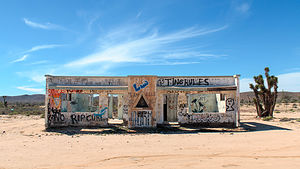 More examples of the economically disadvantaged Baja NorteI have to admit that I was a little nervous about crossing the border. Since I am much more of a stickler for rules than Herb is, to his annoyment I insisted that he bring in only the allowable three liters of beer (per person). If not, I wasn’t coming, fearing I would be thrown into a Mexican prison for smuggling in a 30-pack of Bud. Oddly, they do allow you to bring in six liters of wine or hard liquor, which doesn’t really make any sense to me, but it is the rule - so I followed it. They even have a bizarre rule where you are only allowed to bring in one stair stepper - that’s right. One is allowed, not two.
More examples of the economically disadvantaged Baja NorteI have to admit that I was a little nervous about crossing the border. Since I am much more of a stickler for rules than Herb is, to his annoyment I insisted that he bring in only the allowable three liters of beer (per person). If not, I wasn’t coming, fearing I would be thrown into a Mexican prison for smuggling in a 30-pack of Bud. Oddly, they do allow you to bring in six liters of wine or hard liquor, which doesn’t really make any sense to me, but it is the rule - so I followed it. They even have a bizarre rule where you are only allowed to bring in one stair stepper - that’s right. One is allowed, not two.
As per our agreement, Herb had performed his pre-departure duties of taking care of incidentals to keep us safe and out of jail. Discover Baja is a great resource for anyone traveling to Baja. Through them, Herb was able to get the highly suggested Mexican auto insurance ($25 per day for our intended stay) and the required FMM tourist permits to enter the country. I highly suggest getting the FMM tourist permit through them ahead of time, rather than at the Mexico Immigration Office. Their website also has great info on road conditions and places to see, as well as discounts on hotels, restaurants, and campgrounds throughout Baja.
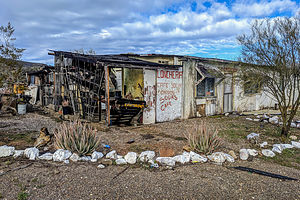 Closed for businessWe very carefully followed the instructions provided by Discover Baja for crossing the San Ysidro / Tijuana border, first stopping at the blue building with the Mexican flag to get our FMM stamped. It was quite uneventful. They didn’t even search our car for excess Budweiser or stair steppers.
Closed for businessWe very carefully followed the instructions provided by Discover Baja for crossing the San Ysidro / Tijuana border, first stopping at the blue building with the Mexican flag to get our FMM stamped. It was quite uneventful. They didn’t even search our car for excess Budweiser or stair steppers.
Back in the car, we crossed over the border and followed the signs for Playas de Tijuana/Rosarito-Ensenada. There are not that many paved roads to choose from in Baja, so all we had to do was follow Mexico 1 the whole way. 1 is supposed to be a toll road, but when we came up to our first toll booth, there was no one in the booth, but just a woman outside it holding a basket. At first we thought she was the toll collector, but when we asked how much, she said “libre,” which even with our limited Spanish vocabulary, we understood to mean free. She was just looking for a donation. This same thing happened at every toll both we passed through.
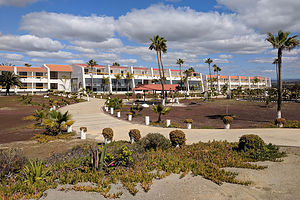 Hotel Mision Santa MariaFirst impressions of northern Baja were that it was a lot more undeveloped than I had anticipated, with much squalor, neglect, and poverty. Many structures (both homes and businesses) were dilapidated. There were junk yards and open garbage dumps (sometimes burning) in every village. The biggest business along the highway was selling llantas (tires) because the roads were so bad. Dogs, cats, chickens, and cows wandered freely alongside and sometimes even on the roads. Asphalt was non-existent except on the few highways that criss-crossed the peninsula, meaning that after a rain, all else was mud. In fact, we saw little girls coming home from school, wearing their Catholic school uniforms, navigating their way through and around the mud, seemingly with without a care. This was, after all, what they knew of life. Who was I to judge?
Hotel Mision Santa MariaFirst impressions of northern Baja were that it was a lot more undeveloped than I had anticipated, with much squalor, neglect, and poverty. Many structures (both homes and businesses) were dilapidated. There were junk yards and open garbage dumps (sometimes burning) in every village. The biggest business along the highway was selling llantas (tires) because the roads were so bad. Dogs, cats, chickens, and cows wandered freely alongside and sometimes even on the roads. Asphalt was non-existent except on the few highways that criss-crossed the peninsula, meaning that after a rain, all else was mud. In fact, we saw little girls coming home from school, wearing their Catholic school uniforms, navigating their way through and around the mud, seemingly with without a care. This was, after all, what they knew of life. Who was I to judge?
The other issue that made things quite stressful was the narrowness of the roads and the lack of a shoulder. For the entire duration of our time in Baja, we traveled on two-lane, undivided highways, with large trucks coming so close that you feared for your mirror each time one passed. The frequency of memorials along the road was a testament to just how dangerous these roads can be. Plus, when you left the towns and villages, the roads often became mountainous and winding. However, one thing I would have to say is that the speed limits reflect these dangers and are often quite slower than you would expect on a highway in the states.
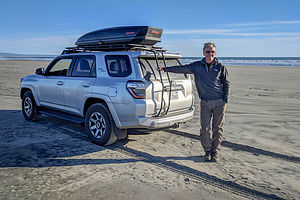 Driving along the beach in San QuintinBecause of my trepidation with traveling in Baja, I had researched hotels and made reservations for our first few nights, selecting the ones in Moon Baja that had stars next to them.
Driving along the beach in San QuintinBecause of my trepidation with traveling in Baja, I had researched hotels and made reservations for our first few nights, selecting the ones in Moon Baja that had stars next to them.
We had chosen the town of San Quintin because it was about the right distance from San Diego (5 hours), had lots of services, and it had what looked like a really nice hotel called the Hotel Mision Santa Maria, right on a wide sandy beach. At $66 American dollars a night, it was a bargain and the most expensive hotel in San Quintin. In hindsight, I wouldn’t have booked two nights if I knew the weather was going to be so cold that we couldn’t spend time on the beach.
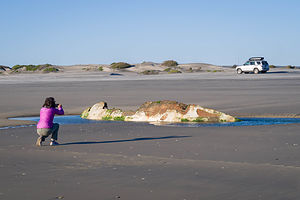 Lolo photographing the shipwreckThe town itself wasn’t so nice, so I was glad that we had to leave Mexico 1 and drive down a dirt road for 3 miles to get to the hotel. I was so relieved when I saw it. It was lovely.
Lolo photographing the shipwreckThe town itself wasn’t so nice, so I was glad that we had to leave Mexico 1 and drive down a dirt road for 3 miles to get to the hotel. I was so relieved when I saw it. It was lovely.
Every room faced the beach and was recently renovated. There was a lovely sunny courtyard with a fountain, and a restaurant on site. The old woman of the optical illusion that I explained in the trip overview was giving way to that lovely young lady.
When making the reservation, on the hotel’s website there was a photo of a vehicle driving on the beach. We asked the desk clerk (the one who spoke English) about the possibility of us doing this. He explained that it was, but that they had to open a gate for us to get through.
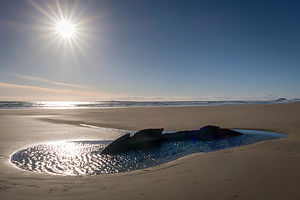 Old shipwreck along the San Quintin beachAfter settling into the room, we decided to head out onto the beach. Sure enough, an employee was there to open the gate for us. Concerned about us getting past the big bumps and drops through the wash preceding the beach, he actually walked out onto the wash to show us the way, using the universal language of pointing and waving his arms in the air when we veered the wrong way.
Old shipwreck along the San Quintin beachAfter settling into the room, we decided to head out onto the beach. Sure enough, an employee was there to open the gate for us. Concerned about us getting past the big bumps and drops through the wash preceding the beach, he actually walked out onto the wash to show us the way, using the universal language of pointing and waving his arms in the air when we veered the wrong way.
The beach had hard sand and was quite easy to drive on. In fact, in seemed to serve as a highway of sorts for locals that sped by in their 2WD cars. Too bad the weather wasn’t better as we would have loved to spend the day relaxing and reading on a sunny beach, but the temperatures were surprisingly cool, even this far south. It didn’t feel much different than home.
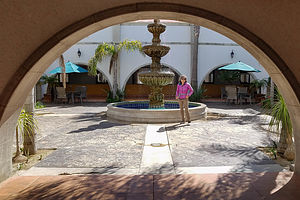 Courtyard of Hotel Mision Santa MariaFar too chilly to put the beach chairs out. Instead, we just explored. Probably the most interesting find was a small pool of water containing the remains of an old shipwreck.
Courtyard of Hotel Mision Santa MariaFar too chilly to put the beach chairs out. Instead, we just explored. Probably the most interesting find was a small pool of water containing the remains of an old shipwreck.
When we headed back to the hotel, our friend was waiting for us to open the gates. He, as everyone else we encountered while in Mexico, was extremely friendly and helpful.
That evening we had a delicious dinner in the hotel dining room. Herb had the chile relleno, which became his go-to during the trip and I had a very good chicken stuffed with spinach and peppers. That plus 2 glasses of white wine cost the equivalent of $22 American dollars (or 424 pesos, which seems so much more).
The next morning we awoke to clear skies, but chilly winds. After our standard breakfast of coffee and Nature Valley Oats and Honey Bars in the room, we took a 4-mile stroll out on the beach. Deciding it was too cool and windy, we spent the day reading in the sunny courtyard, protected from the wind.
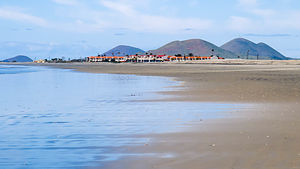 Our hotel off in the distanceLater that afternoon, I went for a 5-mile run on the beach, which basically consisted of me running back and forth on the hard sand in view of Herb’s watchful eyes from our balcony. It felt so good to stretch the legs after so much driving.
Our hotel off in the distanceLater that afternoon, I went for a 5-mile run on the beach, which basically consisted of me running back and forth on the hard sand in view of Herb’s watchful eyes from our balcony. It felt so good to stretch the legs after so much driving.
We returned to the hotel dining room that evening, this time having quesadillas and a veggy omelette.
It had been a nice first stop in Baja, and a place I would highly recommend to anyone making the drive down Mexico 1.
Description
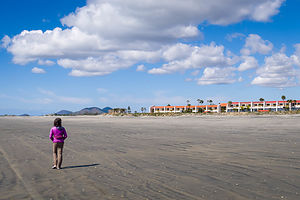 A stroll on the beachSan Quintin, in northern Baja about 5 hours south of the border, is a popular overnight spot for travelers heading south on Mexico 1. The town is primarily agricultural, with strawberries and tomatoes being the main crops. Most visitors head out to the beaches outside of town to spend the night, where it is quieter and more picturesque.
A stroll on the beachSan Quintin, in northern Baja about 5 hours south of the border, is a popular overnight spot for travelers heading south on Mexico 1. The town is primarily agricultural, with strawberries and tomatoes being the main crops. Most visitors head out to the beaches outside of town to spend the night, where it is quieter and more picturesque.
The nicest place to stay is the Hotel Misión Santa Maria, located on a beautiful, sandy beach, with all rooms facing the beach. There is a restaurant and bar on-site.
- ‹ previous
- 2 of 14
- next ›
Border Crossing and San Quintin location map in "high definition"
Javascript is required to view this map.
